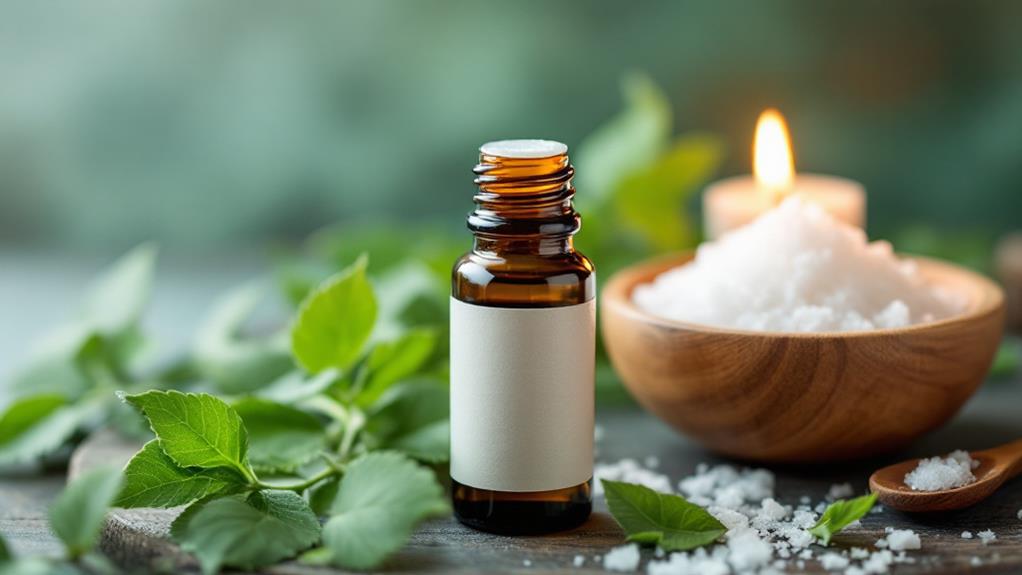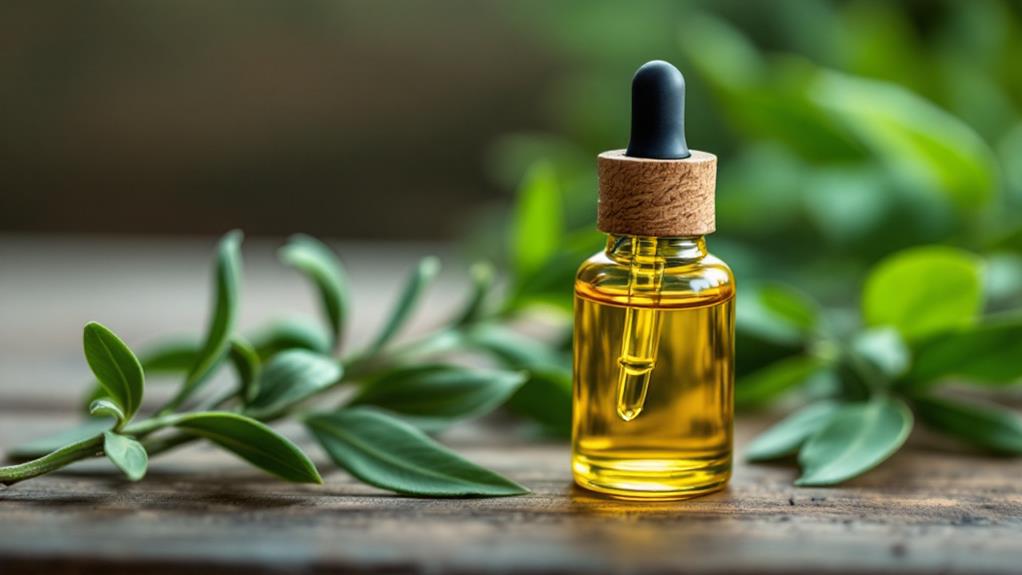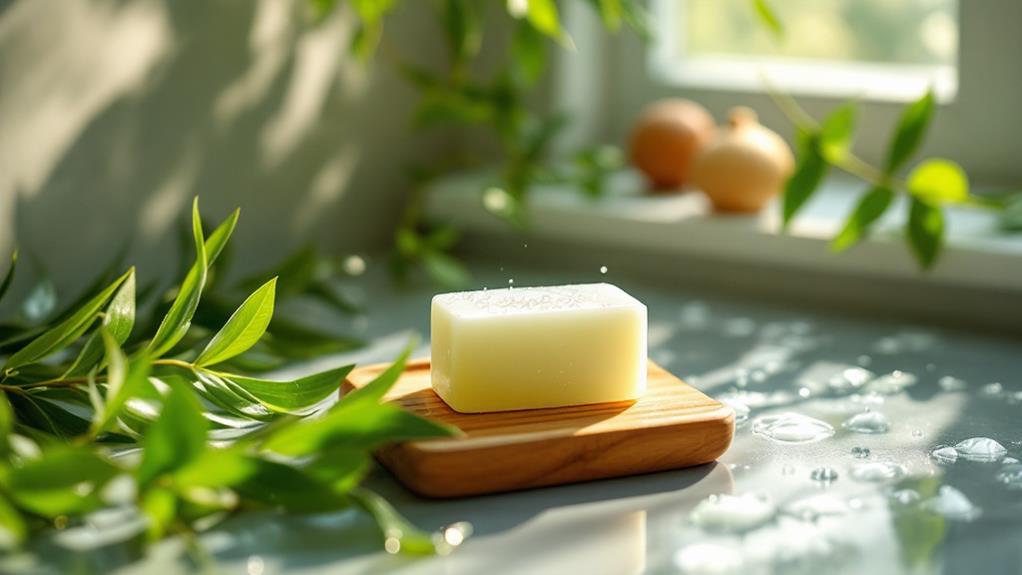Can Tea Tree Oil Be Used to Treat Acne? A Natural Acne Solution

You can use tea tree oil as a natural acne treatment due to its antibacterial and anti-inflammatory properties. It's derived from the Australian Melaleuca alternifolia tree and contains terpinen-4-ol, which fights acne-causing bacteria. A 5% tea tree oil solution can reduce acne lesions with fewer side effects than some conventional treatments. Always dilute it with a carrier oil to avoid skin irritation, and patch test before using it on your face. Start with gentle spot treatments and monitor your skin's reaction. If you're curious about integrating tea tree oil into your routine, there's more to investigate.
What Is Tea Tree Oil?
Tea tree oil, a significant oil with a distinct camphor-like scent, is derived from the leaves of the Melaleuca alternifolia tree native to Australia. This vital oil has been cherished for centuries, particularly by Aboriginal Australians, for its remarkable skin health benefits. Among its most notable features are its antimicrobial properties, which make it a popular choice in addressing skin concerns like acne.
The key compound in tea tree oil, terpinen-4-ol, plays a substantial role in combating acne-causing bacteria. It helps reduce inflammation and redness, vital steps in managing acne-prone skin. This oil, ranging in color from clear to yellow, is commonly found in a variety of skincare products, such as cleansers, spot treatments, and toners. Its effectiveness is supported by research, including a 2007 study that demonstrated a 3.55-fold reduction in pimples when a 5% tea tree oil solution was used over a 12-week period.
Incorporating tea tree oil into your skincare routine can offer a natural solution to maintaining skin health. Its ability to target acne while simultaneously soothing the skin makes it an invaluable asset in your quest for clearer skin.
Acne-Fighting Properties
When battling acne, you'll find tea tree oil to be a powerful ally due to its impressive acne-fighting properties. This natural remedy contains terpinen-4-ol, a compound known for its strong antibacterial properties that target acne-causing bacteria, particularly Propionibacterium acnes. By including tea tree oil in your acne treatment routine, you can effectively combat the root causes of breakouts.
Topical tea tree oil has shown significant promise in reducing inflammation and redness associated with inflammatory acne. Studies have found that regular use can diminish the size of acne lesions, providing a soothing solution without the harsh side effects often experienced with other skin care products. In fact, a 1990 study revealed that a 5% tea tree oil formulation was effective in reducing acne lesions and had fewer side effects compared to traditional treatments like benzoyl peroxide.
For those dealing with mild to moderate acne, tea tree oil offers a natural and non-comedogenic solution that won't clog your pores. This characteristic is fundamental for maintaining clear skin, as it prevents further breakouts. By incorporating tea tree oil into your skincare regimen, you can adopt a gentle yet effective approach to clearer skin.
Comparing to Conventional Treatments
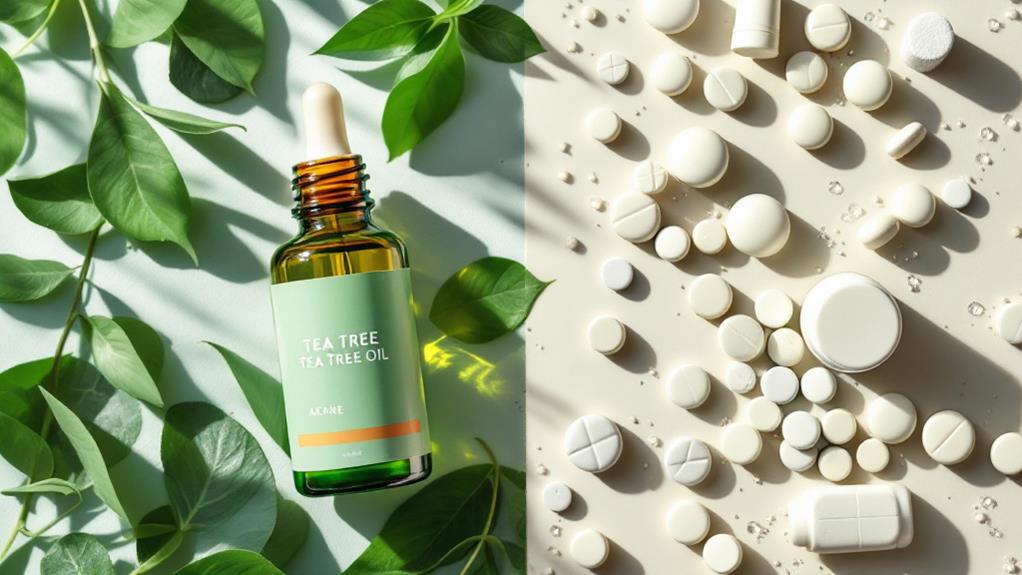
While tea tree oil's natural properties make it a formidable contender in the fight against acne, it's helpful to understand how it stacks up against conventional treatments. One common treatment, benzoyl peroxide, often delivers faster results but can cause skin sensitivity issues like dryness and irritation. In contrast, tea tree oil, with its antimicrobial and anti-inflammatory properties, offers a gentler alternative, especially for those with sensitive skin.
A 1990 study compared both 5% tea tree oil and 5% benzoyl peroxide, revealing similar effectiveness in treating acne. However, tea tree oil users experienced fewer side effects, making it a suitable choice for those seeking a natural alternative. Additionally, tea tree oil is non-comedogenic, meaning it won't clog pores, which is a potential downside of some conventional acne treatments.
For mild to moderate acne, tea tree oil has shown significant efficacy, reducing pimples by 3.55-fold according to a 2007 study. Its versatility allows for multiple applications, such as spot treatments, clay masks, and gels, without the need for prescriptions or specific methods required by many conventional products. Consequently, tea tree oil stands out as a practical and effective option for managing acne.
How to Dilute Properly
Dilution is key when using tea tree oil to avoid skin irritation. You should always dilute it with a carrier oil like coconut or jojoba. A common ratio is 1-2 drops of tea tree oil to 12 drops of carrier oil. This guarantees you maintain the efficacy of the treatment while reducing the risk of irritation. If you have sensitive skin, consider starting with a lower concentration—try 1 drop of tea tree oil to 15 drops of carrier oil. This can help minimize adverse reactions and make your application on acne-prone areas safer.
To make certain you're using tea tree oil safely:
- Pick the right carrier oil: Coconut or jojoba oils are excellent choices.
- Adjust concentration for sensitive skin: Start with a lower tea tree oil concentration.
- Conduct a patch test: Test on your inner forearm before applying to your face.
Pre-mixed skincare products containing tea tree oil are also available. These eliminate the need to manually dilute, guaranteeing the concentration is just right for application. Always conduct a patch test before applying the diluted oil to any acne-prone areas to check for any allergic reactions or skin sensitivity.
Steps for Safe Application
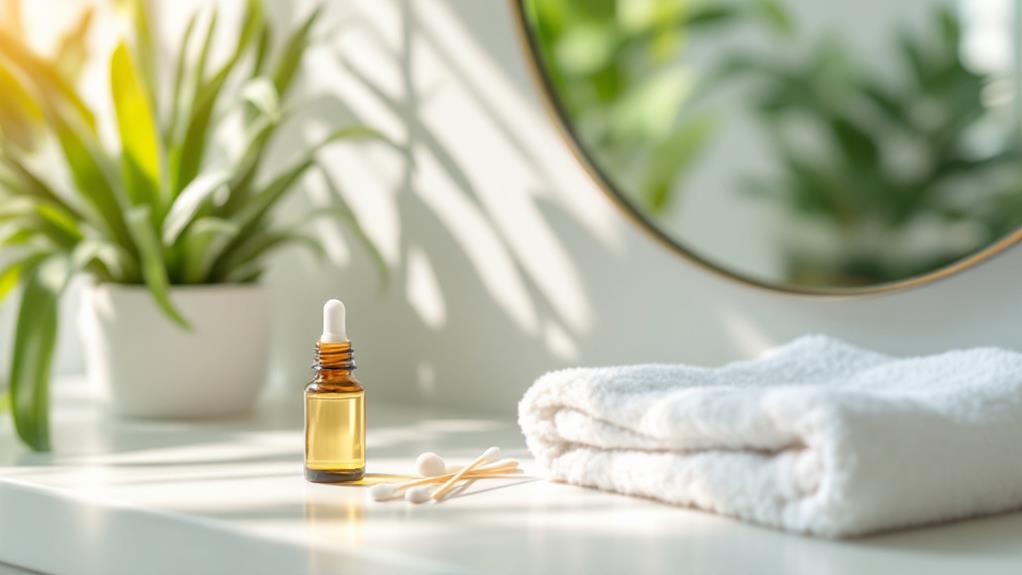
Now that you've learned how to dilute tea tree oil properly, let's focus on applying it safely to acne-prone skin. Begin by confirming you dilute 1-2 drops of tea tree oil with 12 drops of a suitable carrier oil like coconut or jojoba oil to prevent irritation, especially if you have sensitive skin. Next, cleanse your face with a gentle cleanser designed for acne-prone skin to remove impurities and prepare your skin for ideal absorption of the diluted oil.
Before you apply the mixture, it's essential to conduct a patch test on your inner forearm to check for any sensitivity or allergic reactions. Once you've confirmed it's safe, apply the diluted tea tree oil directly to your blemishes using a cotton round or pad. Allow the oil to dry completely before applying your regular moisturizer to keep your skin hydrated and balanced.
Monitor your skin's response over time. If you notice any symptoms like itching or swelling, discontinue use immediately. Consistently observing your skin's reaction will help guarantee that tea tree oil remains a beneficial part of your acne treatment routine without causing unnecessary irritation.
Patch Testing Importance
Patch testing is an essential step before applying tea tree oil to your face, as it helps identify potential allergic reactions or skin sensitivities. To perform a patch test, you should apply diluted tea tree oil—1-2 drops mixed with a carrier oil—on a small area of your inner forearm. Over the next 24 hours, observe reactions such as irritation, redness, or itching. If any of these occur, it's best to discontinue use immediately to prevent further skin damage.
Conducting a patch test offers several benefits:
- Identify Allergic Reactions: Helps you identify if you're allergic to tea tree oil without applying it all over your face.
- Gauge Effectiveness: Allows you to see if the oil is effective in reducing acne before committing to a facial application.
- Prevent Skin Damage: Guarantees you're not risking irritation and redness on your facial skin.
For a more thorough evaluation, consider the left-right trial method. Apply diluted oil to one side of your face to monitor skin response and effectiveness in reducing acne. This approach allows you to compare results and make informed decisions about using tea tree oil in your skincare routine.
Monitoring Skin Reactions
After confirming that tea tree oil is safe for your skin through patch testing, it's essential to keep a close eye on how your skin reacts when you start using it. Begin by applying the oil as a spot treatment on acne-prone areas, and diligently monitor any changes. Watch for signs of irritation such as itching, redness, or swelling. These symptoms may indicate that your skin is sensitive to tea tree oil, and you might need to adjust the frequency or concentration of your application.
Keep an eye on dryness or peeling as well, as these can be signs of overuse or an indication that your skin needs more moisture. If you notice these reactions, consider reducing how often you apply the oil or incorporating a gentle moisturizer into your routine. Monitoring skin reactions over several weeks will help you gauge the treatment's effectiveness. Note if your acne improves or worsens and adjust your approach accordingly. Regular assessment allows you to decide if tea tree oil is the right acne solution for you or if you should investigate alternative treatments. This proactive approach guarantees you get the best results without compromising skin health.
Potential Side Effects
When using tea tree oil for acne treatment, it's crucial to be aware of its potential side effects. One of the most common issues is skin irritation, which can manifest as dryness, blistering, or rashes if the oil is not properly diluted with a carrier oil. Allergic reactions are another concern, as some people might experience symptoms such as itching, redness, or swelling. If you notice these symptoms, it's vital to discontinue use and consult a dermatologist.
Additionally, tea tree oil can increase your skin's sensitivity to sunlight, so don't forget to apply sunscreen when stepping outside. Remember, undiluted application may exacerbate side effects, so always mix with a carrier oil.
Ingesting tea tree oil is toxic and can lead to serious symptoms like confusion and ataxia, so be certain to keep it out of reach of children and pets.
- Always dilute tea tree oil with a carrier oil to minimize skin irritation.
- Be vigilant about any allergic reactions and discontinue use if symptoms occur.
- Guarantee quality by choosing reputable brands and checking product purity and concentration.
Precautions and Safety Tips
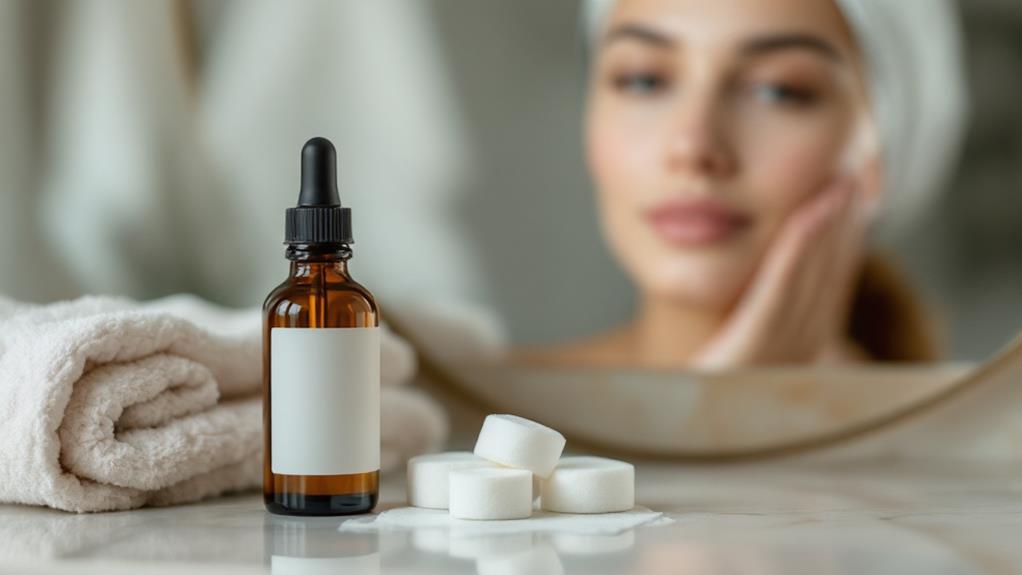
Taking precautions with tea tree oil guarantees a safe and effective acne treatment. To start, always dilute tea tree oil with a carrier oil, like coconut or jojoba oil. Use a recommended ratio of 1-2 drops of tea tree oil to 12 drops of carrier oil to prevent skin irritation. Before applying it to your face, conduct a patch test on your inner forearm. This step helps identify any allergic reactions or sensitivity, as individual responses can vary widely.
Once you've done the patch test, monitor your skin condition closely after applying the mixture. If you notice any signs of irritation, such as itching, redness, or swelling, discontinue use immediately. It's vital to keep in mind that tea tree oil can increase your skin's sensitivity to sunlight. Applying sunscreen is important to protect your skin from UV damage when using tea tree oil topically.
Additionally, pay attention to proper storage. Keep tea tree oil in a cool, dark place, and make sure it's out of reach of children and pets, as it can be toxic if ingested. Following these precautions guarantees a safer experience with tea tree oil in your acne treatment regimen.
Natural Skincare Integration
Incorporating tea tree oil into your natural skincare routine can be a game-changer for tackling acne. This crucial oil's anti-inflammatory properties make it a powerful ally in reducing inflammation and redness linked to acne lesions. For a safe and effective application, dilute 1-2 drops of tea tree oil with 12 drops of a carrier oil such as jojoba or coconut oil. This prevents irritation and helps you reap the benefits of this natural remedy.
Many acne treatments now include tea tree oil due to its antimicrobial qualities, which can promote clearer skin with consistent use. It's a adaptable ingredient that can fit seamlessly into numerous natural skincare regimens. Consider combining it with soothing agents like aloe vera to improve its effectiveness. This combination not only targets acne lesions but also enhances skin health.
Here are some tips for integrating tea tree oil into your routine:
- Spot Treatment: Apply diluted tea tree oil directly on acne lesions.
- Mix with Moisturizer: Blend a few drops into your daily moisturizer.
- DIY Face Mask: Combine it with other natural ingredients for a soothing mask.
Consistent use of tea tree oil can yield noticeable improvements, making it a valuable inclusion to your skincare arsenal.


